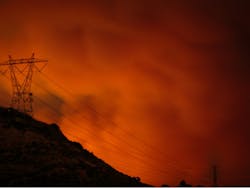A new report warns that California may be heading down the wrong path when it comes to preparing its grid for wildfires and points to microgrids as a better solution.
Utilities are proposing a range of costly investments to the central grid that may take decades, which still leave “substantial risk” for power outages, says “California’s Critical Facility Challenge: The Case for Energy as a Service Municipal Microgrids,” prepared by Navigant for Schneider Electric.
“Unfortunately, utilities and policymakers have yet to recognize the single most logical solution for local governments,” says the white paper. “Microgrids, small islands of emergency power, are capable of sustaining long power outages without jeopardizing public safety, health, and public service obligations of local government critical facilities.”
See related story: With California’s Wildfire Season Coming, San Diego Microgrids Face Two-Year Delay
The finding comes as the state girds for the summer’s wildfire threat, which may lead to as many as 15 forced power outages in some communities, according to the paper. Utilities plan to shut down electricity to vulnerable areas – where over half of utility ratepayers live or work – when the fire threat is high.
Utilities estimate that pre-emptive shut-offs will average two to five days, posing not only “an extreme hardship on citizens but also — and more importantly — jeopardizing critical public service,” the report says.
The shutdowns follow revelations that the grid sparked hundreds of fires over the last several years, costing billions in damages.
Biggest threat? The grid
As already widely reported, the potential liability led Pacific Gas & Electric to file for bankruptcy, an act that “points to the risks now attached to traditional grid infrastructure solutions in an era of accelerated global climate change,” the paper says.
California already ranks first for power outages nationally, a position it held even before the destructive 2017 and 2018 wildfires.
The paper focuses on problems wildfires and power shutdowns create for local government services, including fire districts. Local governments find themselves in a bind. Keeping grid power on can lead to fires; shutting it off can make it hard to fight fires.
“The biggest threat to California’s local governments today is caused by the existing utility grid infrastructure. It is time to reinvent the grid one microgrid at a time, creating a nimble, sustainable, and resilient energy network to safeguard California’s economic and environmental future,” the paper says.
Options for local governments
That’s not to say California isn’t building microgrids. In fact, it’s one of the forerunners in advancing the technology. But still, utilities favor centralized grid upgrades over microgrids, with some exceptions, in their public plans for wildfire mitigation.
The report advises local governments to consider public private partnerships, including energy-as-a-service contracts, an approach used increasingly because it spares communities from taking on risk and large capital costs.
Energy-as-a service, or EaaS, is the most popular business model for microgrids globally and will continue to be so under a decade-long forecast by Navigant. The research firm pegs spending on energy-as-a-service microgrids at $1.7 billion in 2018, growing to over $12.3 billion by 2027 at a compound annual growth rate (CAGR) of 25%.
“New microgrid business models such as EaaS can allow public agencies to move forward with microgrid projects that previously would have required federal or state government grants,” says the paper.
The paper also noted that vendors are increasingly offering more standardized microgrids, which brings down project cost and reduces development time.
Rapid response modular microgrid
For example, Scale Microgrid Solutions and Schneider Electric recently announced that they are teaming up to offer a ‘rapid response modular microgrid.’ The product includes solar PV, lithium ion batteries, and a dispatchable natural gas generator that can meet California’s air quality regulations. The partnership says that the systems can be deployed within one year at $1,500/kW.
Schneider and Scale hope to add 25 MW of rapid response modular microgrids before the 2020 wildfire season begins.
“Microgrids have advanced to the point where access to secure, flexible and affordable power is within the reach of nearly everyone, without the need for an extensive overhaul of the entire grid,” said Mark Feasel, vice president, electric utility segment & smart grid, Schneider Electric. “We believe California’s critical facilities and municipalities need to be evaluating microgrids as part of their overall energy strategy, and we’re proud to offer a guiding resource to simplify the decision process and drive greater adoption in the state.
The report, “California’s Critical Facility Challenge: The Case for Energy as a Service Municipal Microgrids,” is available for free download here.







